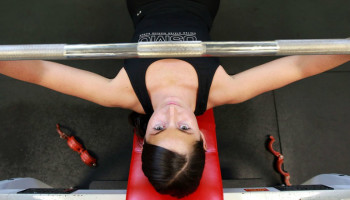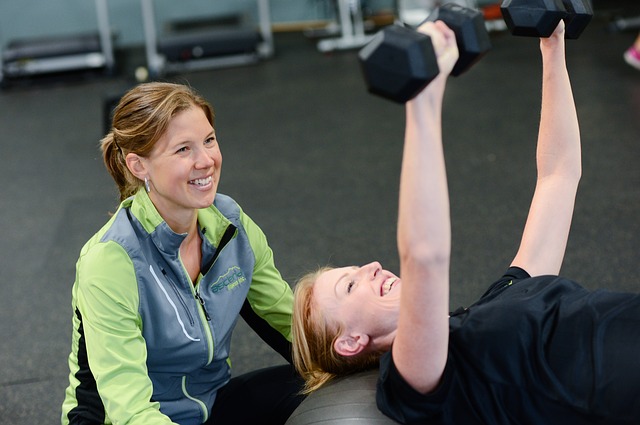 Reading Time: 7 minutes
Reading Time: 7 minutesI admit I cruised through school as a full-time nerd with no time for sports. In my senior year of college, I finally discovered the world of strength training at an all-women’s gym. That’s right, all female members, all female trainers. And I can still tell you the names of each of the women who showed me how to correctly lift weights, whether it was by volunteering to be my workout buddy or sharing new workout programs.
Before long, getting stronger became my passion, not only changing the way I saw myself in the mirror, but also enabling me to improve the lives of others by becoming a personal trainer. As I started meeting with my first clients, I learned the obstacles that frequently stop women from strength training:
- Am I going to bulk up like a bodybuilder?
- Will gaining muscle make my jeans tighter?
- Am I going to weigh more?
- Can I lift once a week and just do cardio the rest of the week?
- Am I going to look like a dude?
- Can we just use the five-pound dumbbells?
Working against the misinformation campaign of women’s fitness magazines, red carpet celebrity workout trends, and body image struggles was and still is no easy feat. But strength training is a good thing for women, and the best way to buck a myth is to seek out scientific fact. Ultimately, educating yourself to the “why” and “how” behind what industry experts practice will fast track you toward the healthy body you’re seeking in the most efficient amount of time.
Here is the simple set of nine motivating factors I share with female clients about the importance of taking on and sustaining a strength training regimen:
1. Gaining Muscle Takes Months
Your physique will not turn into a bodybuilder’s physique overnight. Bodybuilders and figure competitors spend three or more hours in the gym most days of the week, doing high-repetition workouts on a diet designed to build muscle mass. Unless you’ve taken on weight training as a part-time job and have upped your protein to more than a gram per pound of body weight, it’s unlikely you will wake up “bulky” following a week of workouts.
2. Muscle Pump or Feeling “Swole” Is Temporary
Delayed onset muscle soreness (DOMS) is a normal part of getting stronger. In the 24 to 72 hours following a strength-training workout, your muscle tissue will experience some inflammation surrounding the micro tears in muscle fibers caused by strength training. Inflammation is a part of the body’s self-repair process. Once your body “heals,” it comes back stronger than before, and the feeling of swelling you may experience will dissipate.
Note: If you are experiencing DOMS five days or more after a workout, it’s likely the training volume (repetitions and/or weight lifted) was excessive for your current fitness level.
3. Your Clothes Will Fit Better
Your wardrobe will thank you for improving your body composition. Your pants will fit better if you match your strength training with a solid diet of fresh foods and adequate macronutrients. Strength training is a minimum three-day a week commitment and requires fueling your body with optimal nutrition for a premium outcome.
Muscle occupies less space than fat pound for pound, so it’s possible you may weigh slightly more and fit into your clothing better. If you’re finding your jeans are tight, journal your nutritional intake and troubleshoot there. Remember the end game: investing time and energy into a great workout plan can make everything you already own fall better on your figure.
4. Muscle Mass Sustains Weight Loss
Successful, long-term weight loss programs emphasize a strength-training component. As your body weight decreases from a caloric deficit, the body may lose both fat and muscle, but a good fitness regimen will be designed to make this muscle loss as minimal as possible.
The reason this is so critical long term is for weight maintenance. If during weight loss, muscle mass is drastically diminished, your metabolism will tank with it. As soon as a poor diet creeps back in, the likelihood of gaining weight due to a slow metabolism increases.
5. Tuning in to You Pays Off
Strength training dials in your mind-body connection in a way that no repetitive-motion cardio session can provide. In the first two to three months of strength training in particular, new lifters see their biggest results from improving their ability to fire more muscle fibers on demand. This can improve your coordination and ability to move throughout the rest of your day. Improved coordination will reduce your risk of injury, keeping you moving with grace over the long haul.
6. Self-Sufficiency Is Empowering
Strength training can prepare you for whatever life throws in your direction. Whether you’re planning to have your first child, springing yourself out of a moving vehicle in an emergency, or avoiding two trips to carry a week’s worth of groceries, lifting reduces the physical effort required to complete other tasks.
A balanced strength program that incorporates all major muscle groups and gradual increases in volume will provide the greatest gains. Major muscle groups include: chest, back, shoulders, abdominals, quadriceps, and hamstrings. If you begin by focusing on these groups, you will maximize calorie-burning while simultaneously involving secondary muscle groups such as your biceps, triceps, and calves.
In order to increase volume, increase the number of repetitions and/or weight lifted from one week to the next. A general rule of thumb is to keep volume increases between 5-10% from week to week. The last two repetitions of your final set on an exercise should be challenging, while maintaining good form.
7. 5-pound Dumbbells Are Not Your Forever Friends
Triggering fitness results requires stimulus. If the stimulus remains the same, so will you. Five-pound dumbbells have few roles in long-term fitness plans, with the exception of barre classes, introductory strength training, or warmup exercises.
Ease your way up the dumbbell rack and see what you can do. For upper-body exercises you’ll want to increase by 2 to 5 pounds when increasing weight. Lower body exercises allow for 5- to 10-pound jumps. Remember, you can always “drop set,” by trying a heavier weight for as many reps as possible and then dropping the weight down a notch to allow for finishing a set with good form.
8. You Don’t Need Permanent Personal Training
If you’re just starting into strength training, hire a professional. Look for someone with a personal training certification that is difficult to obtain such as NASM or NSCA certifications or a degree in exercise science or kinesiology. Shell out the cash for the person with at least a few years’ experience.
Then, be a student of fitness, not a terminal client. Seek out guidance on what your trainer considers the top ten exercises for your goals and build your repertoire from there. Take notes on your sets, reps, weights, and the exercises you perform. Take the leap and mimic the training session on your own to get the full learning effect.
When you plateau training on your own, go back for more knowledge, and level up. Gathering strategic feedback from a consultant outside of your head-space will yield quicker results. Results will keep you motivated. Learning proper technique is worth the investment, for your own safety and progress.
9. Lifting Confidence Is Hot
Picture yourself speaking at a meeting after several months of a solid resistance-training program. Your posture has improved. You have the mental fortitude of knowing you can out-squat most people you’re speaking to. You know you can endure more than you once imagined. You feel good about you. People will feel this energy coming off you and respond to it.
Strength Training for Women Is About Strength in Numbers
For me, engaging my body in a consistent strength routine is an endless exploration of what I’m capable of. The glory of knocking out a string of pretty pull-ups is something that cannot be measured by a scale or pant size.
If you’re already in the club of women who have discovered strength training, expand your tribe. Find a girlfriend to share the keys of the fitness kingdom with. As someone who was once welcomed in, I promise you — they’ll never forget it.








